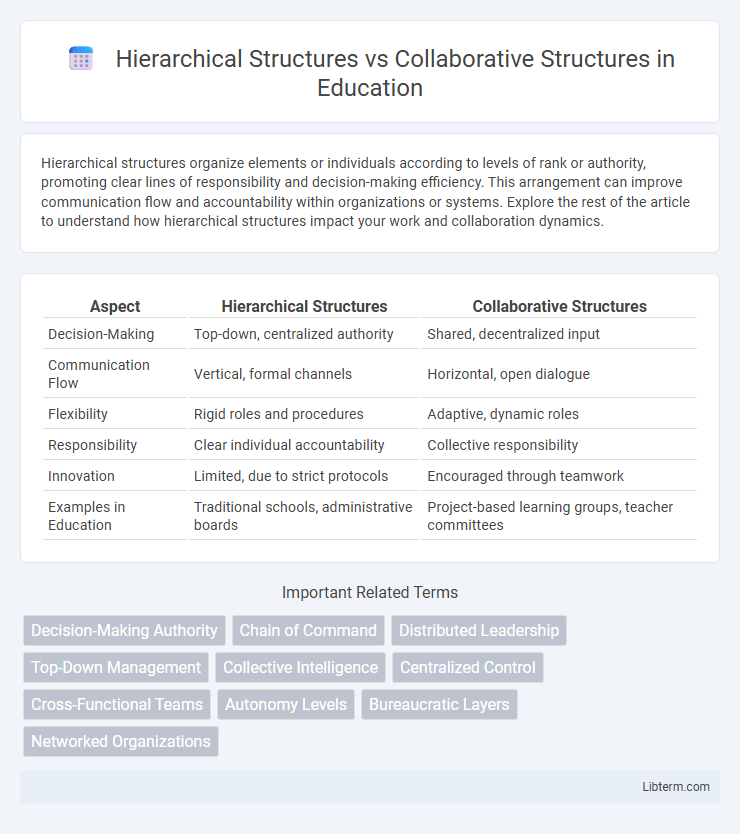Hierarchical structures organize elements or individuals according to levels of rank or authority, promoting clear lines of responsibility and decision-making efficiency. This arrangement can improve communication flow and accountability within organizations or systems. Explore the rest of the article to understand how hierarchical structures impact your work and collaboration dynamics.
Table of Comparison
| Aspect | Hierarchical Structures | Collaborative Structures |
|---|---|---|
| Decision-Making | Top-down, centralized authority | Shared, decentralized input |
| Communication Flow | Vertical, formal channels | Horizontal, open dialogue |
| Flexibility | Rigid roles and procedures | Adaptive, dynamic roles |
| Responsibility | Clear individual accountability | Collective responsibility |
| Innovation | Limited, due to strict protocols | Encouraged through teamwork |
| Examples in Education | Traditional schools, administrative boards | Project-based learning groups, teacher committees |
Introduction to Organizational Structures
Hierarchical structures organize organizations into clearly defined layers of authority, ensuring streamlined decision-making and clear accountability. Collaborative structures emphasize decentralized decision-making, fostering innovation and employee engagement through teamwork and shared responsibilities. Choosing the appropriate organizational structure depends on company size, culture, and strategic objectives to optimize efficiency and adaptability.
Defining Hierarchical Structures
Hierarchical structures organize individuals in a top-down framework, where authority and decision-making flow from upper management to lower levels. Each position within the hierarchy has defined roles and responsibilities, promoting clear lines of accountability and control. This rigid structure supports efficient task execution but may limit flexibility and rapid information exchange.
Key Features of Collaborative Structures
Collaborative structures emphasize decentralized decision-making, fostering open communication and shared responsibilities among team members to enhance innovation and responsiveness. These structures promote cross-functional collaboration, leveraging diverse expertise to solve complex problems and improve organizational agility. Flexibility and adaptability are key features, enabling rapid adjustments to changing market demands and encouraging continuous learning and knowledge sharing.
Decision-Making in Hierarchical vs Collaborative Models
Hierarchical structures centralize decision-making authority, with clear lines of control flowing from top-level management to lower levels, ensuring consistent and swift execution of strategic directives. Collaborative structures distribute decision-making power across teams, fostering shared responsibility and promoting innovative solutions through collective input. The contrast lies in hierarchical models prioritizing control and efficiency, while collaborative models emphasize flexibility and employee engagement in the decision-making process.
Communication Flow and Information Sharing
Hierarchical structures feature top-down communication flows where information passes through defined channels, often resulting in slower decision-making and limited cross-departmental interaction. Collaborative structures promote open, multidirectional communication pathways that facilitate faster information sharing and encourage real-time feedback among team members. Enhanced transparency and collective problem-solving characterize collaborative models, while hierarchical models rely on formal reporting lines to maintain control and consistency.
Flexibility and Adaptability in Each Structure
Hierarchical structures typically exhibit limited flexibility due to rigid chain-of-command and clearly defined roles, which can slow decision-making and reduce adaptability in dynamic environments. Collaborative structures promote high flexibility by encouraging open communication, decentralized decision-making, and cross-functional teamwork, enabling faster responses to changing market conditions. Organizations adopting collaborative frameworks often experience enhanced innovation and agility compared to those relying on traditional hierarchical models.
Impact on Employee Motivation and Engagement
Hierarchical structures often limit employee motivation and engagement by creating rigid chains of command and reducing autonomy, which can stifle creativity and ownership. Collaborative structures enhance motivation by promoting open communication, shared decision-making, and empowerment, fostering a sense of belonging and purpose among employees. Companies with flat, collaborative environments report higher employee satisfaction and increased productivity compared to those operating under traditional hierarchical models.
Efficiency and Performance Outcomes
Hierarchical structures streamline decision-making through clear authority layers, enhancing operational efficiency by reducing ambiguity in roles and responsibilities. Collaborative structures foster innovation and adaptability by promoting cross-functional teamwork and information sharing, leading to improved problem-solving and performance outcomes in dynamic environments. Efficiency tends to be higher in hierarchical models for routine tasks, while collaborative structures excel in complex projects requiring creativity and rapid responsiveness.
Industry Suitability: Which Structure Fits Best?
Hierarchical structures suit industries with clear chains of command and standardized procedures, such as manufacturing, military, and healthcare, where consistent decision-making and accountability are crucial. Collaborative structures excel in creative and technology-driven industries like software development, marketing, and research, fostering innovation through cross-functional teamwork and decentralized decision-making. Choosing the best structure depends on industry demands for flexibility, speed, and control.
Future Trends in Organizational Structures
Future trends in organizational structures emphasize increased adoption of collaborative frameworks, driven by the need for agility and innovation in dynamic markets. Hierarchical structures, while still prevalent for clear authority and decision-making, are evolving to incorporate more decentralized communication and cross-functional teams. Advances in digital technology and remote work capabilities reinforce the shift towards flexible, network-based models that enhance collaboration and knowledge sharing across traditional organizational boundaries.
Hierarchical Structures Infographic

 libterm.com
libterm.com